Search Result
Results for "
voltage sensitive
" in MedChemExpress (MCE) Product Catalog:
2
Biochemical Assay Reagents
2
Isotope-Labeled Compounds
| Cat. No. |
Product Name |
Target |
Research Areas |
Chemical Structure |
-
- HY-D1427
-
|
|
Fluorescent Dye
|
Neurological Disease
|
|
Di-2-ANEPEQ is a voltage sensitive membrane potential fluorescence dye. Di-2-ANEPEQ can be used for the evaluation of voltage-sensitive fluorescence dyes for monitoring neuronal activity in the embryonic central nervous system .
|
-
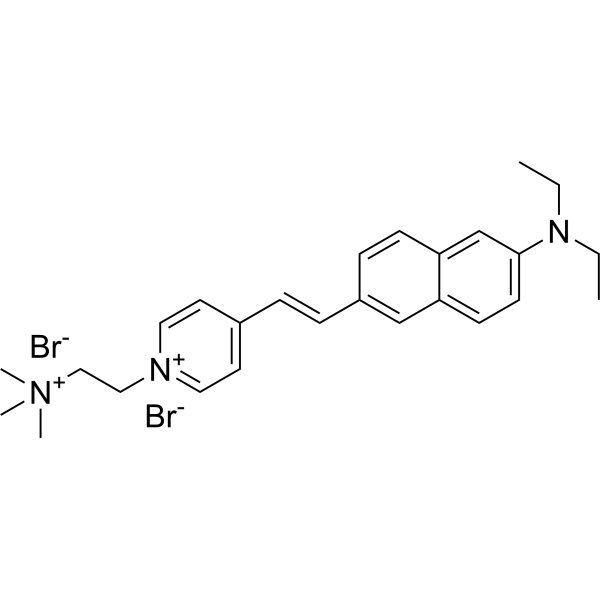
-
- HY-D1512
-
-

-
- HY-P5821
-
-
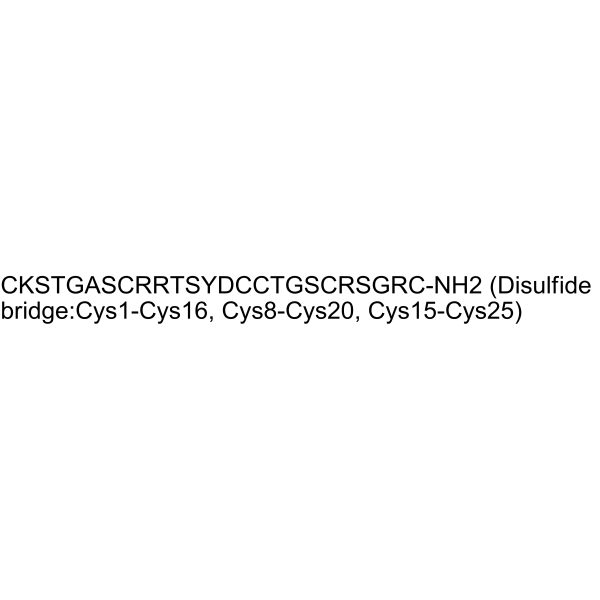
-
- HY-U00218
-
-
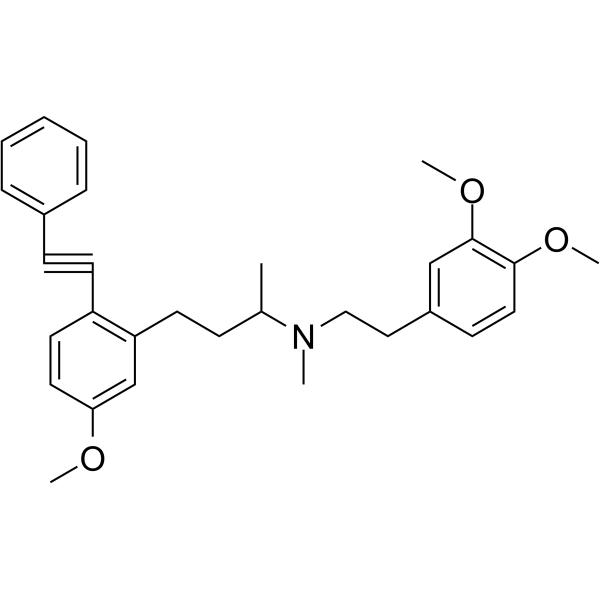
-
- HY-D1439
-
-
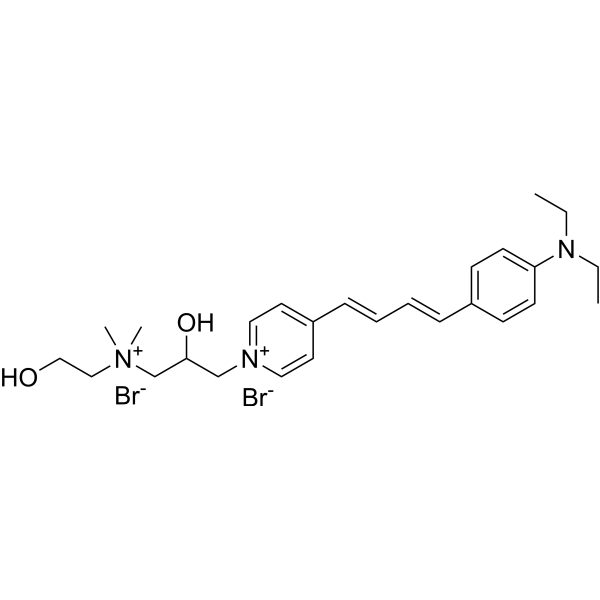
-
- HY-N12093
-
-
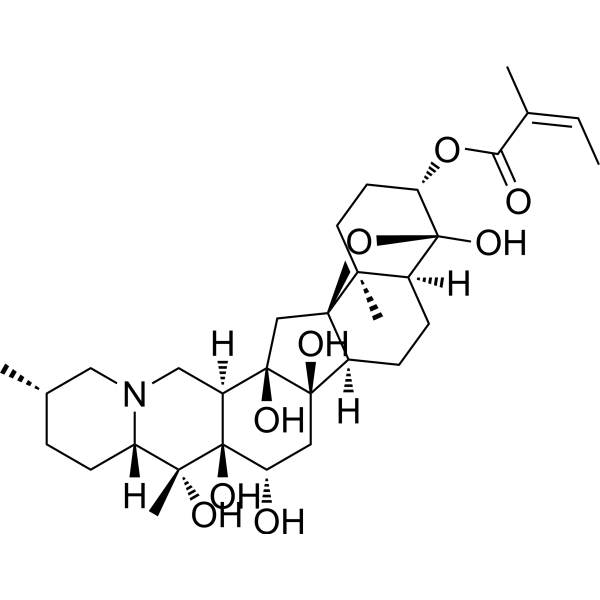
-
- HY-111157
-
-
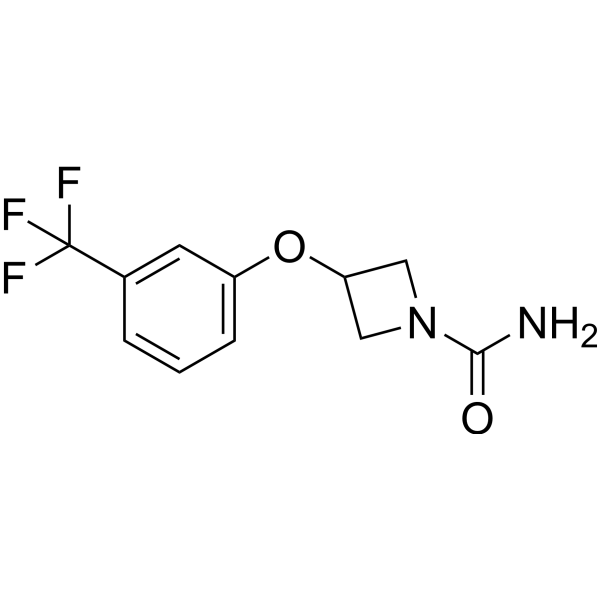
-
- HY-P5868
-
|
|
Sodium Channel
|
Neurological Disease
|
|
mHuwentoxin-IV is a naturally modified Huwentoxin-IV (HY-P1220). mHuwentoxin-IV inhibits tetrodotoxin-sensitive (TTX-S) voltage-gated sodium channels of dorsal root ganglion neurons with an IC50 of 54.16 nM. mHuwentoxin-IV inhibition of tetrodotoxin-sensitive sodium channels is not reversed by strong depolarization voltages .
|
-
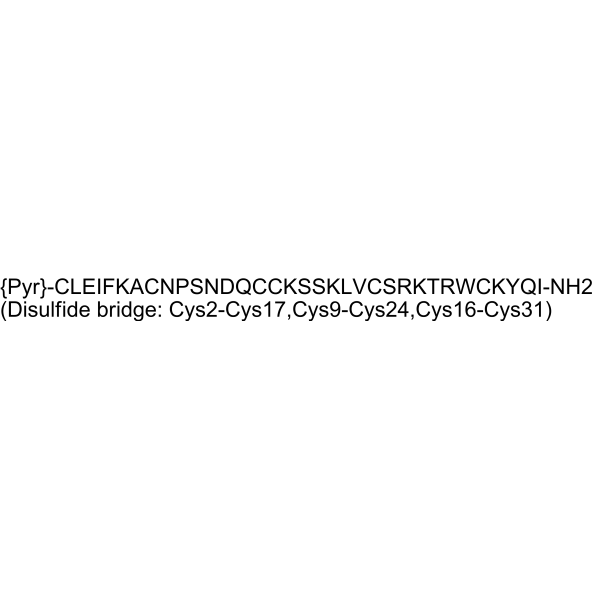
-
- HY-101892
-
-
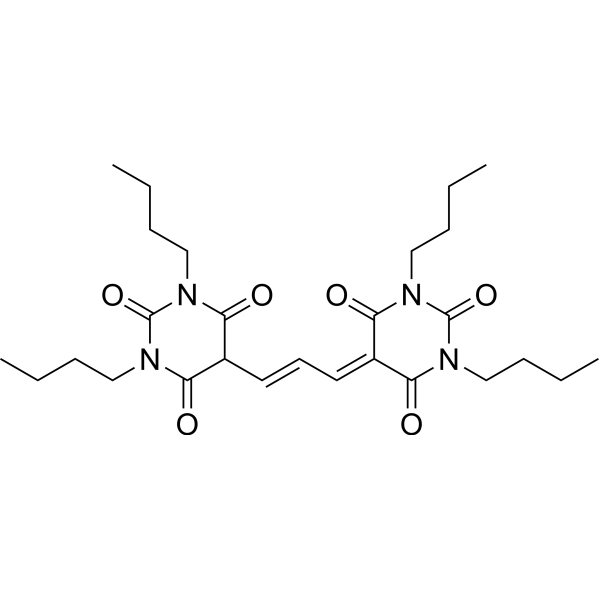
-
- HY-N3990
-
|
(-)-Hardwikiic acid
|
Sodium Channel
|
Infection
Neurological Disease
|
|
Hardwickiic acid ((-)-Hardwikiic acid) is an antinociceptive compound that blocks Tetrodotoxin-sensitive voltage-dependent sodium channels. Hardwickiic acid shows insecticidal activity .
|
-
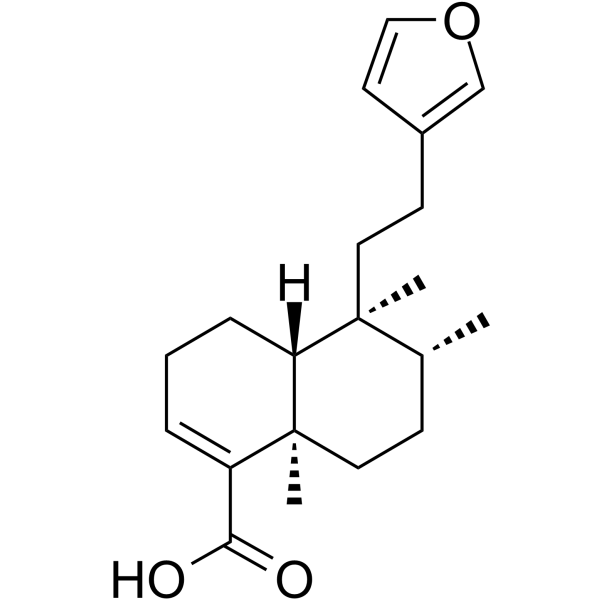
-
- HY-P10025
-
-

-
- HY-103318
-
-
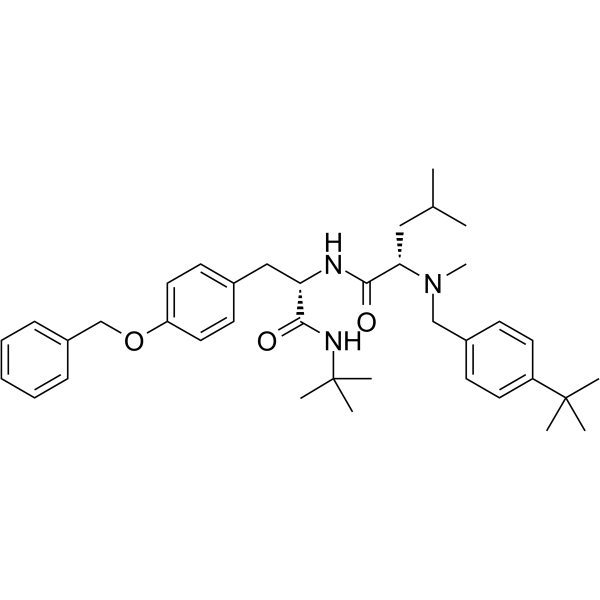
-
- HY-101891
-
|
|
Fluorescent Dye
|
Others
|
|
Di-8-ANEPPS is a naphthylstyryl voltage-sensitive dye, shifting both their fluorescence excitation and emission spectra upon changes in Vm .
|
-

-
- HY-114958
-
|
|
Fluorescent Dye
|
Others
|
|
RH 421 is a voltage-sensitive styryl dye that can penetrate through the lipid bilayers. RH 421 is a chromogenic substrate for β-galactosidase .
|
-
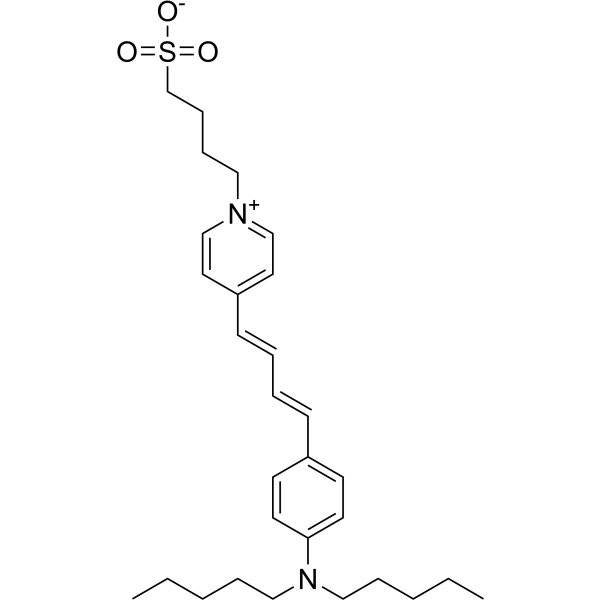
-
- HY-D1092
-
|
|
Fluorescent Dye
|
Neurological Disease
|
|
DiBaC4(5) is a fluorescent voltage-sensitive dye that can be used to monitor the transmembrane potentials when Papain-dissociated retinal cells from adult zebrafish were exposed to GABAergic ligands. DiBaC4(5) is a potential-sensitive fluorescence dye .
|
-
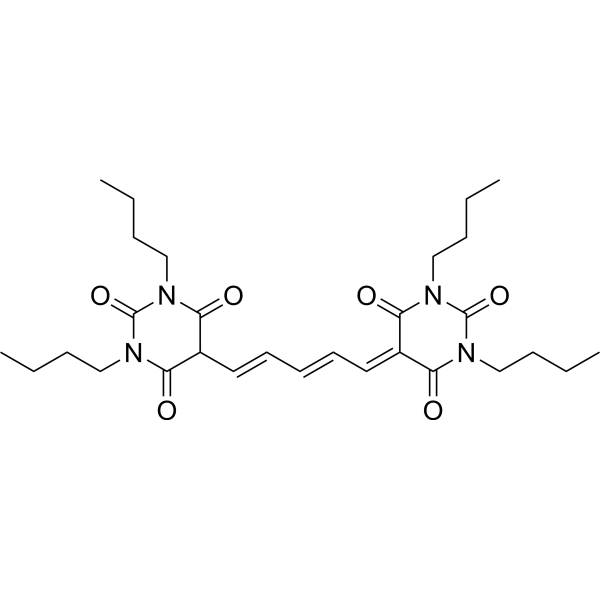
-
- HY-W042039
-
|
|
Calcium Channel
|
Cardiovascular Disease
|
|
Methyl homoveratrate, a metabolite of RWJ-26240 in vivo, can be identified in plasma, urine and faecal extract. McN5691 (RWJ-26240) is a voltage-sensitive calcium channel blocker .
|
-
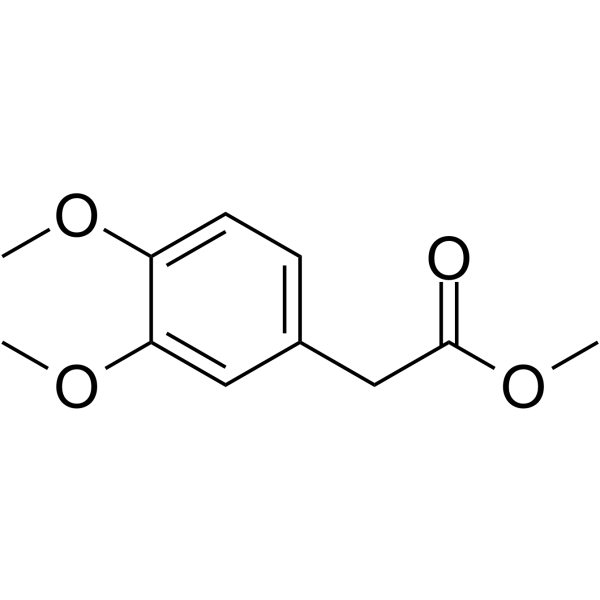
-
- HY-P5143
-
|
|
Calcium Channel
|
Inflammation/Immunology
|
|
ω-Conotoxin SO3 is a blocker of N-type voltage-sensitive calcium channel. ω-Conotoxin SO3 is an analgesicω-conotoxin that can be isolated from the venom of C. striatus .
|
-
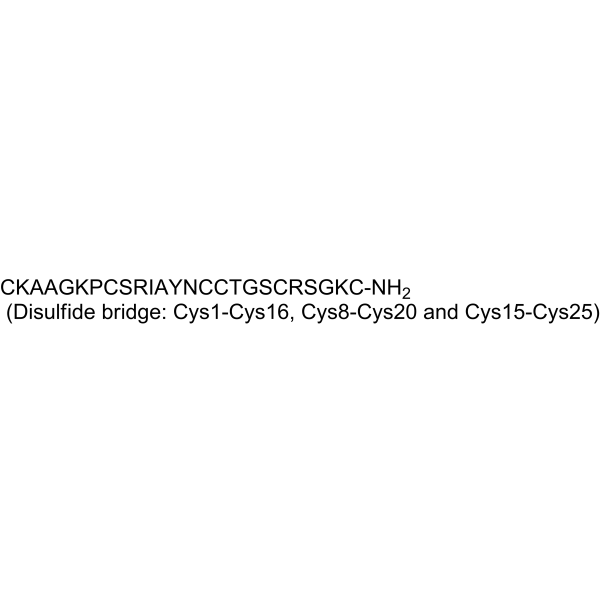
-
- HY-P5184
-
|
HNTX-IV
|
Sodium Channel
|
Neurological Disease
|
|
Hainantoxin-IV is a specific antagonist of Sodium Channel, targeting to tetrodotoxin-sensitive (TTX-S) voltage-gated sodium channels. His28 and Lys32 are the key resiudes of Hainantoxin-IV for binding with target, while Hainantoxin-IV adopts an inhibitor cystine knot motif .
|
-
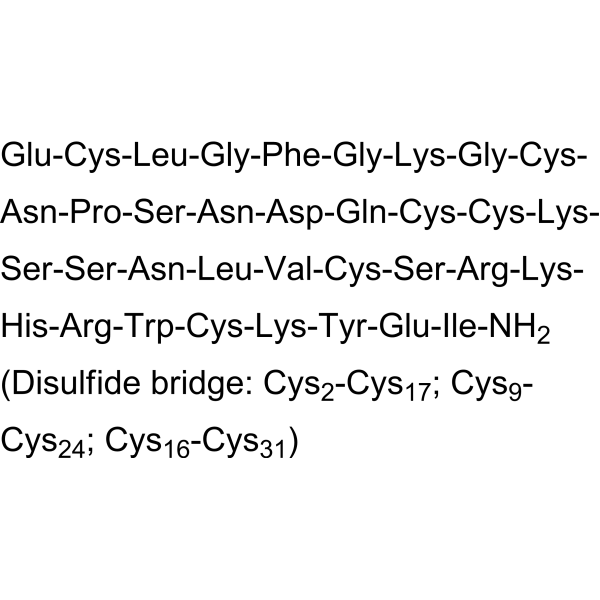
-
- HY-12650S1
-
-

-
- HY-B0246
-
-
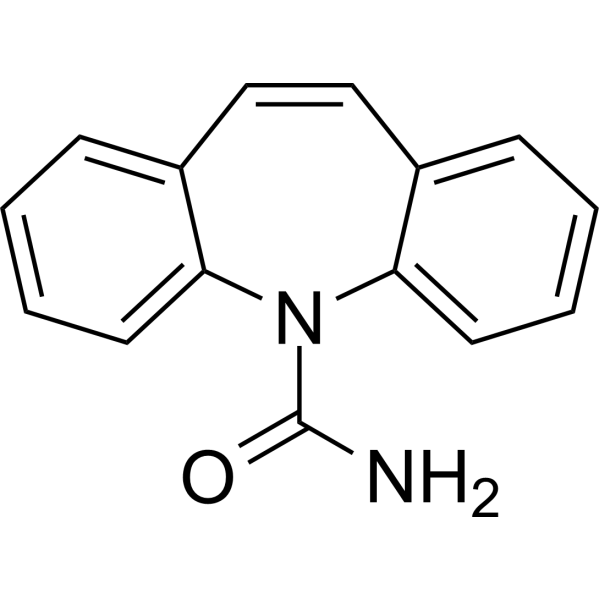
-
- HY-12650
-
|
DS5565
|
Calcium Channel
|
Neurological Disease
|
|
Mirogabalin (DS-5565) is a novel, preferentially selective α2δ-1 ligand characterized by high potency and selectivity to the α2δ-1 subunit of voltage-sensitive calcium channel complexes in the CNS.
|
-

-
- HY-B0122
-
-
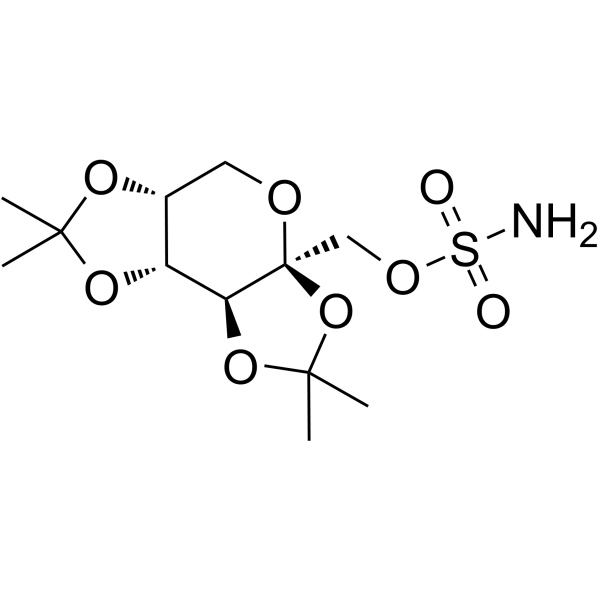
-
- HY-B0122A
-
|
McN 4853 lithium; RWJ 17021 lithium
|
iGluR
GABA Receptor
Sodium Channel
Calcium Channel
Potassium Channel
Carbonic Anhydrase
|
Neurological Disease
|
|
Topiramate (McN 4853) lithium is a broad-spectrum antiepileptic agent. Topiramate lithium is a GluR5 receptor antagonist. Topiramate produces its antiepileptic effects through enhancement of GABAergic activity, inhibition of kainate/AMPA receptors, inhibition of voltage-sensitive sodium and calcium channels, increases in potassium conductance, and inhibition of carbonic anhydrase .
|
-
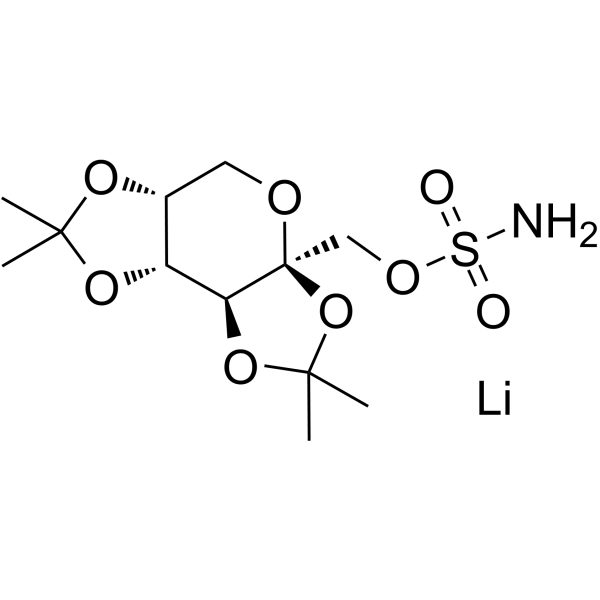
-
- HY-12545
-
|
PbTx-3
|
Sodium Channel
|
Inflammation/Immunology
|
|
Brevetoxin-3 (PbTx-3) is a potent allosteric voltage-gated Na + channel activator and has multiple active centers (A-ring lactone, C-42 of R side chain) . Brevetoxin-3 (PbTx-3) has a high affinity to site 5 of the voltage-sensitive Na + channels, inhibits the inactivation of Na + channels and prolongs the mean open time of these channels. Brevetoxin-3 (PbTx-3) repeated exposures can lead to prolonged airway hyperresponsiveness (AHR) and lung inflammation .
|
-

-
- HY-108425A
-
|
|
Sodium Channel
|
Neurological Disease
|
|
AMG8380, an orally active and less active enantiomer of AMG8379, can serves as a negative control. AMG8380 inhibits human and mouse voltage-gated sodium channel NaV1.7 with IC50s of 0.907 and 0.387 μM, respectively. AMG8380 blocks Tetrodotoxin (TTX)-sensitive native channels with an IC50 of 2560 nM .
|
-
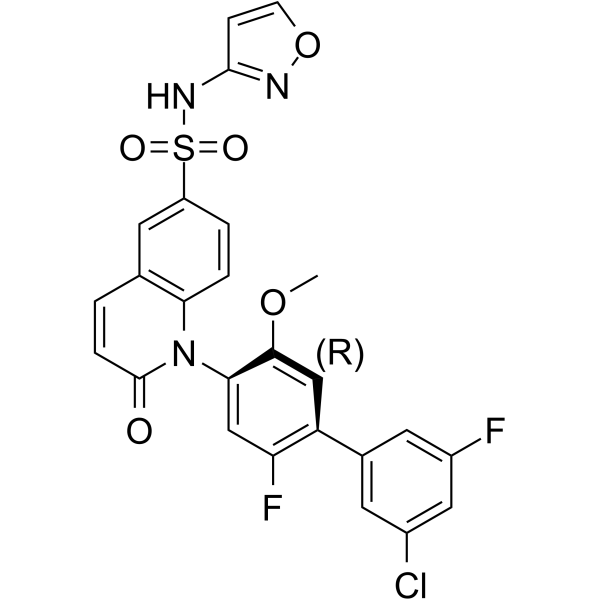
-
- HY-P5771
-
|
|
Sodium Channel
|
Neurological Disease
|
|
Jingzhaotoxin-IX, a C-terminally amidated peptide composed of 35 amino acid residues, is a neurotoxin. Jingzhaotoxin-IX inhibits voltage-gated sodium channels (both tetrodotoxin-resistant and tetrodotoxin-sensitive isoforms) and Kv2.1 channel. Jingzhaotoxin-IX has no effect on delayed rectifier potassium channel Kv1.1, 1.2 and 1.3 .
|
-

-
- HY-110234
-
|
McN 4853 D12 ; RWJ 17021 D12
|
iGluR
GABA Receptor
Sodium Channel
Calcium Channel
Potassium Channel
Carbonic Anhydrase
|
Neurological Disease
|
|
Topiramate D12 (McN 4853 D12) is a deuterium labeled Topiramate. Topiramate is a broad-spectrum antiepileptic agent. Topiramate is a GluR5 receptor antagonist. Topiramate produces its antiepileptic effects through enhancement of GABAergic activity, inhibition of kainate/AMPA receptors, inhibition of voltage-sensitive sodium and calcium channels, increases in potassium conductance, and inhibition of carbonic anhydrase .
|
-
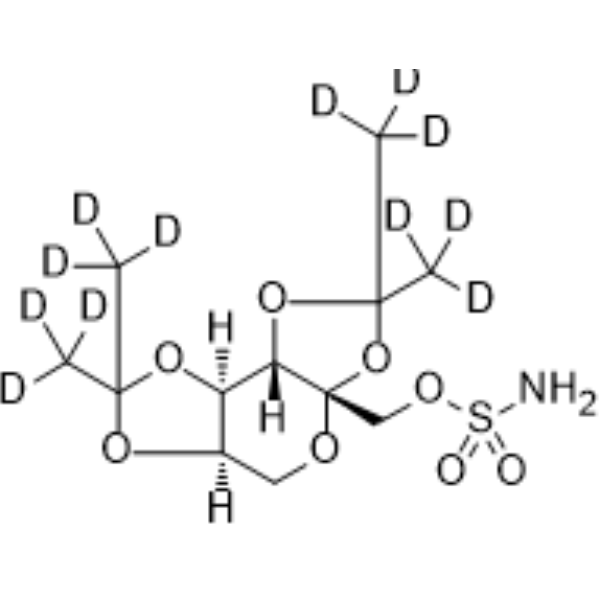
-
- HY-12650R
-
|
|
Calcium Channel
|
Neurological Disease
|
|
Mirogabalin (Standard) is the analytical standard of Mirogabalin. This product is intended for research and analytical applications. Mirogabalin (DS-5565) is a novel, preferentially selective α2δ-1 ligand characterized by high potency and selectivity to the α2δ-1 subunit of voltage-sensitive calcium channel complexes in the CNS.
|
-

-
- HY-B0246R
-
|
|
Sodium Channel
Autophagy
Mitophagy
Potassium Channel
Calcium Channel
HDAC
|
Neurological Disease
Cancer
|
|
Carbamazepine (Standard) is the analytical standard of Carbamazepine. This product is intended for research and analytical applications. Carbamazepine is an orally active pressure-sensitive sodium ion channel blocker with an IC50 of 131 μM. Carbamazepine blocks voltage gated Na +, Ca 2+, and K + channels, and is also a HDAC inhibitor (IC50: 2 μM). Carbamazepine is an anticonvulsant and can be used for research of epilepsy and neuropathic pain .
|
-

-
- HY-110358
-
|
|
Sodium Channel
|
Inflammation/Immunology
|
|
QAQ dichloride, a photoswitchable voltage-gated Nav and Kv channels blocker, blocks channels in its trans form (of the azobenzene photoswitch), but not in its cis form. QAQ dichloride is membrane-impermeant and only infiltrates pain-sensing neurons that express endogenous import channels. QAQ dichloride acts as a light-sensitive analgesic and can be used for studying of signaling mechanisms in acute and chronic pain .
|
-
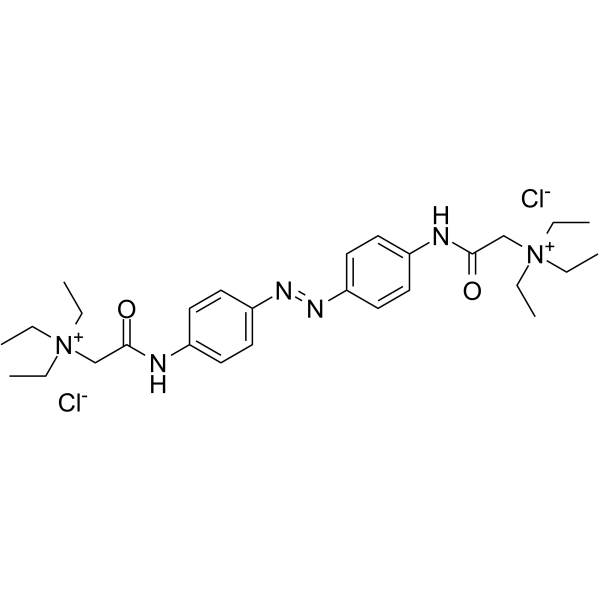
-
- HY-108425
-
|
|
Sodium Channel
|
Neurological Disease
|
|
AMG8379 is a potent, orally active and selective sulfonamide antagonist of the voltage-gated sodium channel NaV1.7, with IC50s of 8.5 and 18.6 nM for hNaV1.7 and mNaV1.7, respectively. AMG8379 potently and reversibly blocks endogenous Tetrodotoxin (TTX)-sensitive sodium channels in dorsal root ganglia (DRG) neurons with an IC50 of 3.1 nM .
|
-
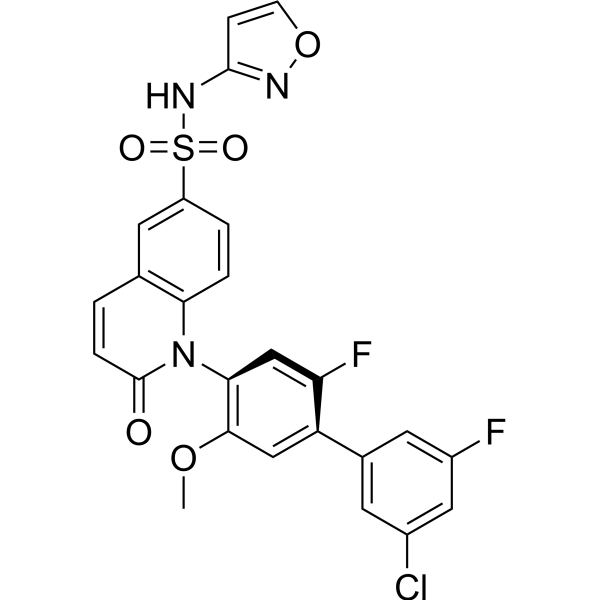
-
- HY-110358A
-
|
|
Sodium Channel
|
Inflammation/Immunology
|
|
QAQ dichloride dichloride, a photoswitchable voltage-gated Nav and Kv channels blocker, blocks channels in its trans form (of the azobenzene photoswitch), but not in its cis form. QAQ dichloride dichloride is membrane-impermeant and only infiltrates pain-sensing neurons that express endogenous import channels. QAQ dichloride dichloride acts as a light-sensitive analgesic and can be used for studying of signaling mechanisms in acute and chronic pain .
|
-

-
- HY-125452
-
|
|
Fluorescent Dye
|
Others
|
|
DiSBAC10 is a voltage-sensitive fluorescent probe used to study cell membrane electrical activity in FRET assays. In a resting polarized cell, DiSBAC10 resides on the outer leaflet of the membrane where it accepts photons from excited fluorescein-labeled proteins and re-emits the photons at a higher wavelength. Depolarization of the cell causes rapid translocation of DiSBAC10 to the inner leaflet of the membrane, thereby increasing the distance between fluorophores and reducing the FRET signal.
|
-
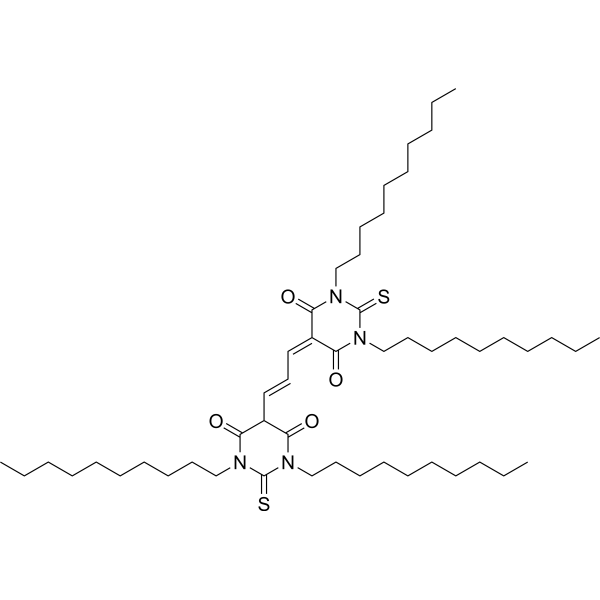
-
- HY-140677
-
|
mPEG-NH2 (MW 5000)
|
PROTAC Linkers
|
Cancer
|
|
mPEG-amine (mPEG-NH2) (MW 5000) is a modifier that can replace the sulfonic acid portion of the dye molecule to increase the water solubility of long-wavelength voltage-sensitive dyes (VSD) or Pittsburgh (PGH) dyes. mPEG-amine can also form amide bonds with carboxyl groups on the surface of microspheres under the mediation of EDC and Sulfo-NHS to form a PEG coating on the surface of fluorescent microspheres for large-scale rotational cytoplasmic flow studies .
|
-
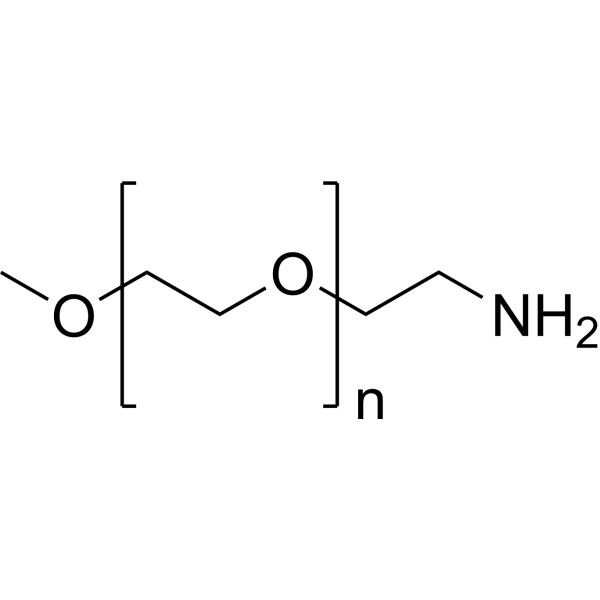
-
- HY-12650S
-
|
DS5565-13C2,d1 (Mixture of Diastereomers)
|
Isotope-Labeled Compounds
|
Others
|
|
Mirogabalin-13C2,d1 (Mixture of Diastereomers) is a C13 and deuterium labeled Mirogabalin. Mirogabalin (DS-5565) is a novel, preferentially selective α2δ-1 ligand characterized by high potency and selectivity to the α2δ-1 subunit of voltage-sensitive calcium channel complexes in the CNS .
|
-

-
- HY-129763
-
|
|
Fluorescent Dye
|
Others
|
|
Di-4-ANEPPS is a voltage-sensitive dye in membrane potential. Di-4-ANEPPS allows reaching a time resolution better than 1 ms and exhibits changes in fluorescence of up to 10% per 100 mV. Di-4-ANEPPS is a common tool for mapping cardiac electrical activity. Di-4-ANEPPS demonstrate significant direct irreversible effect on spontaneous heart rate and ventricular impulse conduction in rabbit isolated heart model .
|
-
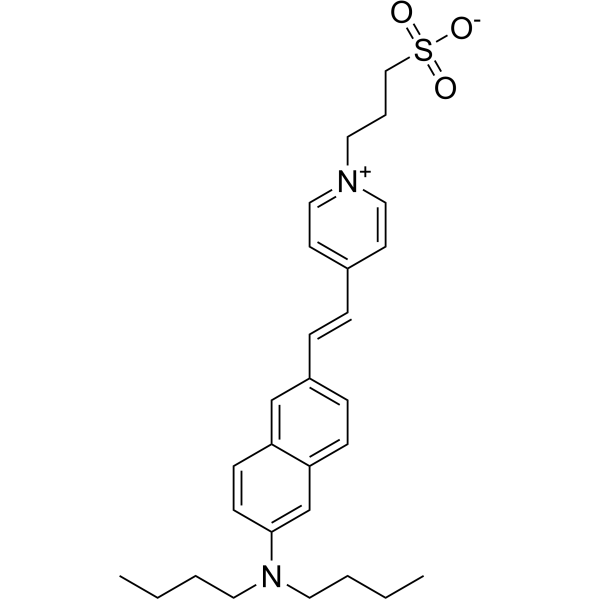
-
-
HY-L118
-
|
|
130 compounds
|
|
Sodium channels conduct sodium ions (Na+) through a cell's plasma membrane that are the source of excitatory currents for the nervous system and muscle. Na channels are classified according to the trigger that opens the channel for such ions, i.e. either a voltage-change (Voltage-gated, voltage-sensitive, or voltage-dependent sodium channel also called VGSCs or Nav channel) or a binding of a substance (a ligand) to the channel (ligand-gated sodium channels). Dysfunction in voltage-gated sodium channels correlates with neurological and cardiac diseases, including epilepsy, myopathies, pain and cardiac arrhythmias. Sodium channel blockers are used in the treatment of cardiac arrhythmia, pain and convulsion.
MCE offers a unique collection of 130 sodium channel blocker and antagonists, all of which have the identified inhibitory effect on sodium channels. MCE Sodium Channel Blocker Library can be used for neurological and cardiac diseases drug discovery and sodium channel research.
|
| Cat. No. |
Product Name |
Type |
-
- HY-D1427
-
|
|
Fluorescent Dyes/Probes
|
|
Di-2-ANEPEQ is a voltage sensitive membrane potential fluorescence dye. Di-2-ANEPEQ can be used for the evaluation of voltage-sensitive fluorescence dyes for monitoring neuronal activity in the embryonic central nervous system .
|
-
- HY-D1512
-
-
- HY-101892
-
-
- HY-101891
-
|
|
Fluorescent Dyes/Probes
|
|
Di-8-ANEPPS is a naphthylstyryl voltage-sensitive dye, shifting both their fluorescence excitation and emission spectra upon changes in Vm .
|
-
- HY-114958
-
|
|
Fluorescent Dyes/Probes
|
|
RH 421 is a voltage-sensitive styryl dye that can penetrate through the lipid bilayers. RH 421 is a chromogenic substrate for β-galactosidase .
|
-
- HY-D1092
-
|
|
Fluorescent Dyes/Probes
|
|
DiBaC4(5) is a fluorescent voltage-sensitive dye that can be used to monitor the transmembrane potentials when Papain-dissociated retinal cells from adult zebrafish were exposed to GABAergic ligands. DiBaC4(5) is a potential-sensitive fluorescence dye .
|
-
- HY-125452
-
|
|
Fluorescent Dyes/Probes
|
|
DiSBAC10 is a voltage-sensitive fluorescent probe used to study cell membrane electrical activity in FRET assays. In a resting polarized cell, DiSBAC10 resides on the outer leaflet of the membrane where it accepts photons from excited fluorescein-labeled proteins and re-emits the photons at a higher wavelength. Depolarization of the cell causes rapid translocation of DiSBAC10 to the inner leaflet of the membrane, thereby increasing the distance between fluorophores and reducing the FRET signal.
|
-
- HY-129763
-
|
|
Dyes
|
|
Di-4-ANEPPS is a voltage-sensitive dye in membrane potential. Di-4-ANEPPS allows reaching a time resolution better than 1 ms and exhibits changes in fluorescence of up to 10% per 100 mV. Di-4-ANEPPS is a common tool for mapping cardiac electrical activity. Di-4-ANEPPS demonstrate significant direct irreversible effect on spontaneous heart rate and ventricular impulse conduction in rabbit isolated heart model .
|
| Cat. No. |
Product Name |
Type |
-
- HY-140677
-
|
mPEG-NH2 (MW 5000)
|
Drug Delivery
|
|
mPEG-amine (mPEG-NH2) (MW 5000) is a modifier that can replace the sulfonic acid portion of the dye molecule to increase the water solubility of long-wavelength voltage-sensitive dyes (VSD) or Pittsburgh (PGH) dyes. mPEG-amine can also form amide bonds with carboxyl groups on the surface of microspheres under the mediation of EDC and Sulfo-NHS to form a PEG coating on the surface of fluorescent microspheres for large-scale rotational cytoplasmic flow studies .
|
-
- HY-111157
-
|
AHR11748; AN051; ADD94057
|
Cell Assay Reagents
|
|
Dezinamide (ADD94057) is an antiepileptic agent. Dezinamide binds to the voltage-sensitive sodium channel .
|
| Cat. No. |
Product Name |
Target |
Research Area |
-
- HY-P5821
-
-
- HY-P5868
-
|
|
Sodium Channel
|
Neurological Disease
|
|
mHuwentoxin-IV is a naturally modified Huwentoxin-IV (HY-P1220). mHuwentoxin-IV inhibits tetrodotoxin-sensitive (TTX-S) voltage-gated sodium channels of dorsal root ganglion neurons with an IC50 of 54.16 nM. mHuwentoxin-IV inhibition of tetrodotoxin-sensitive sodium channels is not reversed by strong depolarization voltages .
|
-
- HY-P10025
-
-
- HY-P5143
-
|
|
Calcium Channel
|
Inflammation/Immunology
|
|
ω-Conotoxin SO3 is a blocker of N-type voltage-sensitive calcium channel. ω-Conotoxin SO3 is an analgesicω-conotoxin that can be isolated from the venom of C. striatus .
|
-
- HY-P5184
-
|
HNTX-IV
|
Sodium Channel
|
Neurological Disease
|
|
Hainantoxin-IV is a specific antagonist of Sodium Channel, targeting to tetrodotoxin-sensitive (TTX-S) voltage-gated sodium channels. His28 and Lys32 are the key resiudes of Hainantoxin-IV for binding with target, while Hainantoxin-IV adopts an inhibitor cystine knot motif .
|
-
- HY-P5771
-
|
|
Sodium Channel
|
Neurological Disease
|
|
Jingzhaotoxin-IX, a C-terminally amidated peptide composed of 35 amino acid residues, is a neurotoxin. Jingzhaotoxin-IX inhibits voltage-gated sodium channels (both tetrodotoxin-resistant and tetrodotoxin-sensitive isoforms) and Kv2.1 channel. Jingzhaotoxin-IX has no effect on delayed rectifier potassium channel Kv1.1, 1.2 and 1.3 .
|
| Cat. No. |
Product Name |
Category |
Target |
Chemical Structure |
| Cat. No. |
Compare |
Product Name |
Species |
Source |
Compare Products
|
| Products |
|
| Cat. No. |
|
| Species |
|
| Source |
|
| Tag |
|
| Accession |
|
| Gene ID |
|
| Molecular Weight |
|
| Purity |
|
| Endotoxin Level |
|
| Biological Activity |
|
| Appearance |
|
| Formulation |
|
| Storage & Stability |
|
| Shipping |
|
| Free Sample |
Yes
No
|
| Size |
* This product has been "discontinued".
Optimized version of product available:
|
| Cat. No. |
Product Name |
Chemical Structure |
-
- HY-12650S1
-
|
|
|
Mirogabalin-d4 (DS5565-d4) is a deuterated compound of Mirogabalin (HY-12650), a ligand that selectively targets the voltage-sensitive calcium channel complex α2δ-1 .
|
-

-
- HY-12650S
-
|
|
|
Mirogabalin-13C2,d1 (Mixture of Diastereomers) is a C13 and deuterium labeled Mirogabalin. Mirogabalin (DS-5565) is a novel, preferentially selective α2δ-1 ligand characterized by high potency and selectivity to the α2δ-1 subunit of voltage-sensitive calcium channel complexes in the CNS .
|
-

Your information is safe with us. * Required Fields.
Inquiry Information
- Product Name:
- Cat. No.:
- Quantity:
- MCE Japan Authorized Agent:













































